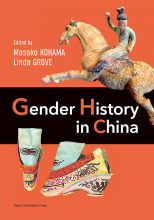Gender History in China
目次
Figures
Contributors
Acknowledgement
Preface: Gender Order in Chinese History
– KOHAMA Masako
PART I
Phase I: Pre-Qin to Sui-Tang: Classical China – The Formation of Patrilineal Society
Introduction
– SHIMOKURA Wataru
1. Gender Structure in Pre-Qin China from an Archaeological Perspective
– UCHIDA Junko
2. The Patrilinealization of Society
– SHIMOKURA Wataru
3. Literature and Women in China
– SATAKE Yasuko
4. The Family in the Tang Period
– WONG Yu-Hsuan
Column 1: Introduction of Historical Materials: Wives’ Divorce and Daughters’
Inheritance of Property, Seen in Dunhuang Documents
– ARAKAWA Masaharu
Column 2: Empress Wu Zetian and Thereafter
– KANEKO Shūichi
Phase II: Song to Ming-Qing: Traditional China – The Strengthening of Gender Norms
Introduction
– SASAKI Megumi
5. Livelihood and Gender in the Tang and Song Dynasties
– ŌSAWA Masaaki
Focal Point: An Overview of Shiga Shūzō’s Principles of Chinese Family Law
– SASAKI Megumi
6. Traditional Family Ideology and the Chen-Zhu School
– SASAKI Megumi
7. Marriage and ‘Chastity’: Structure and Change
– GOMI Tomoko
8. The Sense of Social Status and Gender
– KISHIMOTO Mio
Column 3: Court Ladies and Gender
– OGAWA Yoshiyuki
Phase III: Modern and Contemporary China – Changing Gender Order
Introduction
– TAKASHIMA Kō
9. Nationalism and Gender
– SAKAMOTO Hiroko
10. Masculinity in Modern China
– TAKASHIMA Kō
11. Discourses on the Family, Love and Sex in Modern China
– EGAMI Sachiko
12. Women’s Labor in Modern and Contemporary China
– Linda GROVE
13. The Founding of the People’s Republic of China and the Transformation of
Gender Order
– KOHAMA Masako
14. Rearrangement of Gender Order in Post-Mao China:
Changing Networks of Women’s Federations
– OHASHI Fumie
Column 4: Two Histories of Women in Modern China
– SUDŌ Mizuyo
PART II
15. The Household Register and the Family in Ancient China
– WASHIO Yūko
16. Perceptions of ‘Talented Women’
– ITAHASHI Akiko
17. Healthcare, the Body and Gender in Chinese Medicine
– YAO Yi
18. The History of Women’s/Gender Studies and Feminism in China
– AKIYAMA Yōko
Column 5: Sexual Minorities
– TŌYAMA Hideya
Column 6: Theatre and Gender
– NAKAYAMA Fumi
Bibliography
Index


